WATERLOO STATION,
Australia — The helicopter swung down to a cluster of Brahman cattle, hovering
close enough for the dawn sun to be seen in their eyes. Born and bred on a
fenceless expanse of golden grass and red dirt in the Australian outback, where
horses, dingoes, and crocodiles share the land, these animals are wild enough
to charge a chopper.
اضافة اعلان
But not this time.
After some defiant staring from a bull, the herd turned toward a landmark
called Revolver.
“Pressure and
release,” Jake Mason, the helicopter’s pilot, said as he pulled back into the
big blue sky of northern Australia. “You show them what you want, then let them
do it.”
It was the start of a
long and unusual food journey rarely seen by outsiders. Eventually, many of the
cattle at Waterloo Station would end up on giant trucks called road trains to
cross the outback, then on boats to Indonesia, where they would be fattened and
slaughtered according to guidelines blending Islamic practices with Western
ideas of animal welfare.
Few supply chains
offer as distinct a cultural blend — and few countries ship more live animals
overseas than Australia, exporting 1 million cattle a year, on average, since
2017.
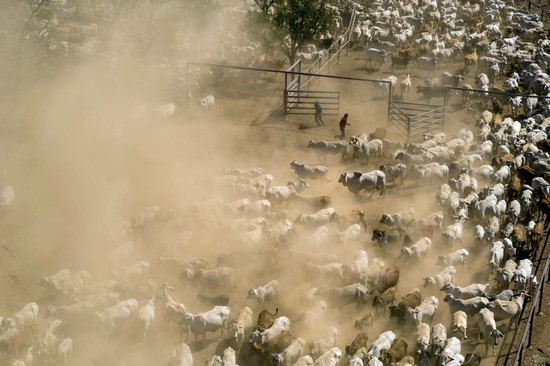 Brahman cattle are
sorted at Waterloo Station in the Northern Territory of Australia on August 22,
2022.
Brahman cattle are
sorted at Waterloo Station in the Northern Territory of Australia on August 22,
2022.
To critics, the
practice is needlessly cruel. In 2011, Australian officials briefly suspended
the trade over concerns about mistreatment, mostly once the cattle reached
Indonesia. But in an increasingly fragmented world, both countries have doubled
down on what, in their view, amounts to a model of globalization. Northern
Australia has ample land to raise cattle but not enough affordable feed to
bring them to their full weight; Indonesia has plenty of agricultural waste for
feedlots and 275 million people who are hungry for beef from Islamic butchers.
“There is a very good
symbiosis,” said Bill Farmer, a former Australian ambassador to Indonesia who
oversaw an industry review after the temporary shutdown. “It actually suits
both countries very well.”
Across the last
frontierEpic scale and
geography define the move from open range to dinner plate.
Australia’s Northern
Territory is often called the last frontier. It is a hot, fierce wilderness
twice as big as Texas with a population of fewer than 250,000. In the NT, you
are a fool if you do not drive with two spare tires and tonnes of water. Last
December, a couple who had been lost for days walked nearly 40 miles before
finding help after their car got caught in a flood.
Live export provides
about 13,000 jobs out this way. And at ports and cattle stations, the business,
which began in the 19th century, tends to be spread out.
The largest ranch in the
US, King Ranch in Texas, is 825,000 acres. The largest cattle station in
Australia is 5.85 million acres, while the largest in the NT sprawls across 4
million.
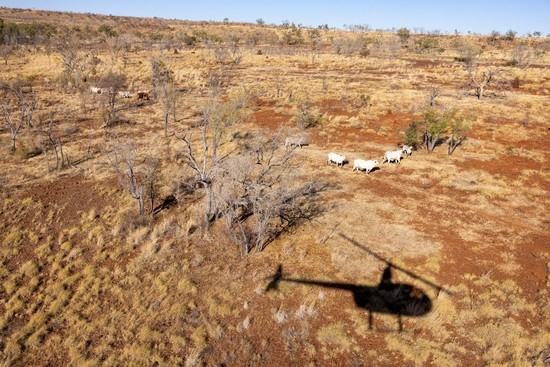 Cattle after loading
onto the Girolando Express, a specialized livestock carrier, at the port of
Darwin, Australia, on August 20, 2022. The trip north to Indonesia, typically
to Jakarta or Lampung, takes about four days.
Cattle after loading
onto the Girolando Express, a specialized livestock carrier, at the port of
Darwin, Australia, on August 20, 2022. The trip north to Indonesia, typically
to Jakarta or Lampung, takes about four days.
Waterloo Station,
while considered relatively small, is roughly three times as large as New York
City. A couple of dozen people call the place home. Rocky ravines line the
landscape. Electricity comes from a diesel generator. Children are taught by
what are still called governesses, and grunt work is shared; workers and owners
alike wash their own dishes.
Round-up,
helicopter styleIt is a similar
situation at huge neighboring stations like Bunda, where distances can be hard
to fathom. Rounding up tens of thousands of cattle requires flying far and wide
to find a few animals, then a few hundred.
“There’s a helicopter
pilot and a bull runner I know who does 1,000 kilometers a day,” said Troy
Setter, CEO of Consolidated Pastoral Co., which owns Bunda.
At 600 miles, that is
farther than Paris to Prague.
At Waterloo, flying is
also the only way for cowboys to do their work. Hamish Brett, 45, often pilots
his own helicopter between the three properties he owns as the head of Brett
Cattle Co. Nearly half the members of the young staff have helicopter licenses
or are getting them.
“It’s a good skill to
have in this environment,” Brett said.
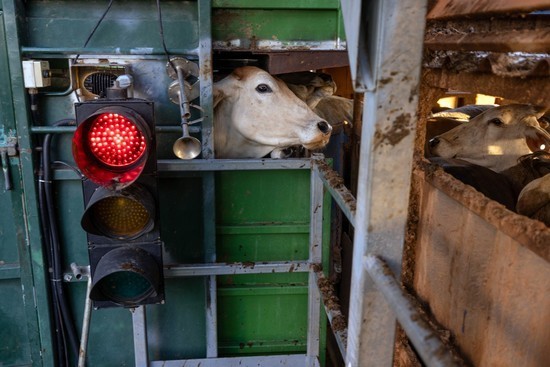 Brahman cattle are
surveyed from a helicopter at Waterloo Station in the Northern Territory of
Australia on August 23, 2022.
Brahman cattle are
surveyed from a helicopter at Waterloo Station in the Northern Territory of
Australia on August 23, 2022.
It is also dangerous.
His parents bought Waterloo in 2004 from John Quintana, an American rodeo
champion. Quintana was killed when his small plane crashed in 2013. Brett’s
older brother, Dougal, died after a helicopter crash in 2015 at Waterloo.
Into the mind of a
cowDuring muster season
in late August, Brett, who is also a licensed veterinarian, was happy to show
two visitors around for a week — usually on the ground.
For most pilots, that
is where the learning starts. Mason, who is a heli-muster leader at just 23,
spent six years on horses and motorcycles learning how the mind of a cow or
bull works. He spends so many hours in the air now that he can easily maneuver
his two-seat flying machine, a bubble of glass with an engine, as if it were a
toy.
“Cattle want to go where the water flows,” he said while flying with a reporter, speaking with the laconic pace of a grizzled ranch hand. “They want to go downhill.” Long pause. “Where the river goes.”
“Cattle want to go
where the water flows,” he said while flying with a reporter, speaking with the
laconic pace of a grizzled ranch hand. “They want to go downhill.” Long pause.
“Where the river goes.”
Once the cattle
clustered at a water point, Mason flew especially close to guide the group into
fenced-off yards. He often left the smallest calves behind — the ones near
mothers with “big bagged-up udders”. It was a small act of compassion that he
said was common in the heli-muster ranks.
But even for steak
lovers, the scenes that followed were more wince-inducing.
In tight quarters, the
smallest calves were branded, castrated, and vaccinated. Lockie Kallis, 23, the
lead stockman, also cut the horns off them to keep them from hurting people or
one another, creating a steady drip of blood.
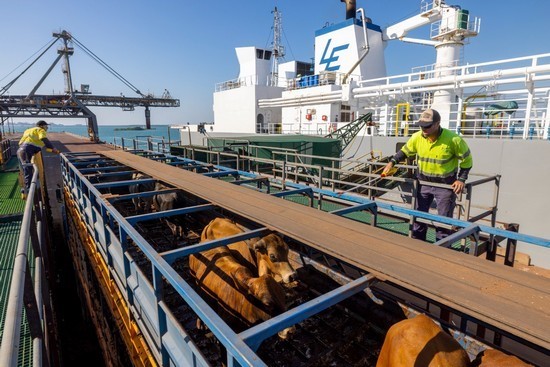 Cattle are loaded
onto the Girolando Express, a specialized livestock carrier, at the port of
Darwin, Australia, on August 21, 2022.
Cattle are loaded
onto the Girolando Express, a specialized livestock carrier, at the port of
Darwin, Australia, on August 21, 2022.
The “weaners”, cattle
big enough to be readied for export, were moved out by truck to a quarantine
station closer to Darwin. Brett — playing his veterinary role — walked through
their ranks, eyeing them for symptoms of illness: snot in the nose, signs of
fatigue.
Another jaunt by road
landed them at the port. At dawn, the entire wharf seemed to rattle with cattle
clomping out of two-tier trucks and onto a narrow ramp leading to the Girolando
Express. The livestock carrier, built in 2014, looked like an oil tanker
crossbred with a cruise ship. Its windowless decks can hold about 4,000 cattle.
Workers moved the
startled Brahman along by standing behind them and yelling or banging the side
of the truck, since cattle are especially sensitive to noise, until they
boarded the boat.
A harrowing journey?Advocacy groups insist
that the journey is unethical.
“There are inherent
risks with transport, and when you add a sea voyage to that, it accelerates those
risks exponentially,” said Jed Goodfellow, the policy director for the
Australian Alliance for Animals.
Tom Dawkins, CEO of
the Northern Territory Livestock Exporters Association, said that losing even a
single animal was costly and unwanted. Darwin is closer to Indonesia than to
Sydney. The Girolando’s journeys, typically to Jakarta or Lampung, last about
four days.
Shipping sheep from
Australia to the Middle East takes longer and is considered more problematic,
with a mortality rate of around 0.21 percent. The mortality rate for cattle
shipped overseas from Australia last year was 0.08 percent, according to
government figures.
 Cattle are loaded onto
the Girolando Express at the port of Darwin, Australia, on August 20,
2022.
Cattle are loaded onto
the Girolando Express at the port of Darwin, Australia, on August 20,
2022.
Andrew Fisher, the
director of the Animal Welfare Science Center at the University of Melbourne’s
Veterinary School, said many of the cattle add weight in transit, a sign that
they do not find the journey especially stressful.
Indonesian
slaughterhouses have proved harder to manage. In 2011, an investigative report
on Australian television showed cattle struggling against workers trying to cut
their throats.
Fisher said the
handful of slaughterhouses featured in the report lacked the facilities to
properly control the animals; they were built for smaller Indonesian breeds.
Can a world of pristine locavore food photos on Instagram make room for the grime and logistics of international cattle raising and killing?
“It was a very
difficult situation for both man and animal,” Fisher said.
The suspension that
followed, lasting more than a month, infuriated Australia’s cattle stations and
Indonesia’s slaughterhouses. In a class-action lawsuit filed by cattle
stations, it became clear that the government could have focused narrowly on
problematic slaughterhouses.
The Bretts, who were
lead plaintiffs, estimated that they had lost out on sales of tens of thousands
of cattle. In 2020, the judge overseeing the class-action case ruled against
the government, and the Bretts were awarded about $2 million. Other companies
are awaiting payouts.
‘Better’ slaughterIn the meantime, much
has changed. A pilot program with more monitoring is now the industry standard,
with electronic tags on every mooing export’s ear to track deaths and slaughterhouse
practices. The most significant shift included adding nonlethal stunning to the
process — knocking the animals out before they are killed, a practice that some
Muslim countries do not consider halal but that Indonesia has found to be in
line with Islamic practice.
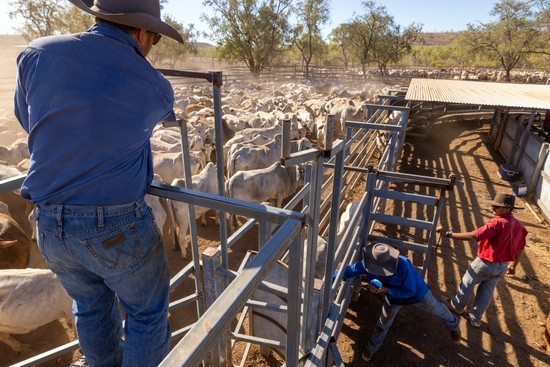 Brahman cattle are
mustered at Waterloo Station in the Northern Territory of Australia on August 22,
2022.
Brahman cattle are
mustered at Waterloo Station in the Northern Territory of Australia on August 22,
2022.
“In terms of
slaughter, it’s getting better and better,” said Fauzan Khumaidi, a technical
adviser for Great Giant Pineapple, an Indonesian pineapple behemoth that sells
its rinds to local feedlots. “It’s not a problem for the slaughterhouses to
fulfill the Australian policy.”
Many station owners
worry that more regulation is coming, that the life they love will eventually
be outlawed. It is too much of a throwback and too global, they say. Can a
world of pristine locavore food photos on Instagram make room for the grime and
logistics of international cattle raising and killing?
“Nowadays, people in
cities have no connection to the land,” Brett said after mustering.
But for now, at least,
the allure of station life — and a form of globalization among neighboring
democracies that mostly works — remains as strong as the dust cloud winds that
blow through the Northern Territory. The Australian government has not moved to
restrict live cattle exports, even as New Zealand recently decided to ban
livestock export by sea. At Waterloo and elsewhere, Brahman herds are growing
and being readied for the journey north.
Read more Odd and Bizarre
Jordan News



